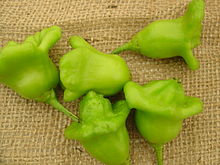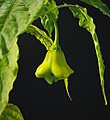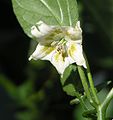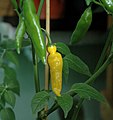| Capsicum baccatum | |
|---|---|

| |
| Bishop's crown fruits | |
| Scientific classification | |
| Kingdom: | Plantae |
| Clade: | Tracheophytes |
| Clade: | Angiosperms |
| Clade: | Eudicots |
| Clade: | Asterids |
| Order: | Solanales |
| Family: | Solanaceae |
| Genus: | Capsicum |
| Species: | C. baccatum |
| Binomial name | |
| Capsicum baccatum L. | |
| Synonyms | |
| |
Capsicum baccatum (Spanish: ají) is a member of the genus Capsicum, and is one of the five domesticated chili pepper species. The fruit tends to be very pungent, and registers 30,000 to 50,000 on the Scoville heat unit scale.
Botany
Chili pepper varieties in the C. baccatum species have white or cream colored flowers, and typically have a green or gold corolla. The flowers are either insect or self-pollinated. The fruit pods of the baccatum species have been cultivated into a wide variety of shapes and sizes, unlike other capsicum species, which tend to have a characteristic shape. The pods typically hang down, unlike a Capsicum frutescens plant, and can have a citrus or fruity flavor.
Cultivated baccatum (C. baccatum var. pendulum) is the domesticated pepper of choice of Bolivia, Colombia, Ecuador, Peru, and Chile. The Moche culture often represented fruits and vegetables in their art, including ají amarillo peppers. South American farmers also grow C. baccatum as ornamental plants for export.
Cultivars

This species of chili pepper includes the following cultivars:
- Ají amarillo, also called amarillo chili and ají escabeche
- Bishop's crown
- Lemon drop, ají limón or ají limo
- Piquanté pepper
Culinary use
The C. baccatum species, particularly the ají amarillo chili, has its origins in ancient Peru and across the Andean region of South America. It is typically associated with Peruvian cuisine, and is considered part of its condiment trinity together with red onion and coriander. Ají amarillo literally means "yellow chili"; however, the yellow color appears only when cooked, as the mature pods are bright orange.
Ají amarillo is one of the ingredients of Peruvian and Bolivian cuisines. It is used as a condiment, especially in many dishes and sauces. In Peru the chilis are mostly used fresh, and in Bolivia dried and ground. Common dishes with ají amarillo are the Peruvian stew ají de gallina ("hen chili"), Papa a la Huancaína, and the Bolivian fricasé Paceño, among others. In Ecuadorian cuisine, ají amarillo, onion, and lemon juice (amongst others) are served in a separate bowl with many meals as an optional condiment. In Colombian, Peruvian, and Ecuadorian cuisines, ají sauce is also a common condiment.
Etymology

Some form of the word ají has been used since approximately 4600 BCE. It was first used in the protolanguage Otomanguean. It then spread along with the Capsicum fruit from Central and South America to other pepper growing regions. Capsicum baccatum is still referred to as ají, while other peppers are referred to as "pepper" via the Spanish conquistadors noting the similarity in heat sensation to black pepper.
The Latin binomial name is made up of Capsicum from the Greek kapos, and baccatum meaning "berry-like".
See also
References
- "The Plant List".
- "Capsicum baccatum". Germplasm Resources Information Network. Agricultural Research Service, United States Department of Agriculture. Retrieved 15 December 2017.
- Albrecht, Elena; Zhang, Dapeng; Mays, Anne; Saftner, Robert A.; Stommel, John R. (2012). "Genetic diversity in Capsicum baccatum is significantly influenced by its ecogeographical distribution". BMC Genetics. 13 (68): 68. doi:10.1186/1471-2156-13-68. PMC 3496591. PMID 22866868.
- Berrin, Katherine & Larco Museum. The Spirit of Ancient Peru : Treasures from the Museo Arqueológico Rafael Larco Herrera. New York: Thames & Hudson, 1997.
- ^ Dave DeWitt and Paul W. Bosland (2009). The Complete Pepper Book: A Gardener's Guide to Choosing, Growing, Preserving, and Cooking. Timber Press. ISBN 978-0881929201.
- Weaver, William Woys. "How to Grow Aji Limo". Mother Earth News.
- Rêgo, Elizanilda Ramalho do; Rêgo, Mailson Monteiro do; Cruz, Cosme Damião; Finger, Fernando Luiz; Casali, Vicente Wagner Dias (2010-11-09). "Phenotypic diversity, correlation and importance of variables for fruit quality and yield traits in Brazilian peppers (Capsicum baccatum)". Genetic Resources and Crop Evolution. 58 (6): 909–918. doi:10.1007/s10722-010-9628-7. ISSN 0925-9864. S2CID 6136758.
- Kraft, Kraig (2014). "Multiple lines of evidence for the origin of domesticated chili pepper, Capsicum annuum, in Mexico". Proc Natl Acad Sci USA. 111 (17): 6165–6170. Bibcode:2014PNAS..111.6165K. doi:10.1073/pnas.1308933111. PMC 4035960. PMID 24753581.
External links
- Eshbaugh, W. Hardy. Peppers: History and Exploitation of a Serendipitous New Crop Discovery (1993)
- "Capsicum baccatum". Plants for a Future.
| Taxon identifiers | |
|---|---|
| Capsicum baccatum |
|



